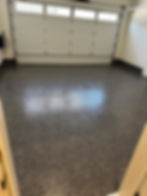POLYASPARTIC COATING

Polyaspartic Floor Coating
.png)
Polyaspartic floor coating is a type of protective coating that is commonly applied to concrete floors. They are highly durable and resistant to chemicals, abrasions, and impacts. Polyaspartic coatings also provide flexibility, enabling them to withstand temperature and humidity fluctuations without cracking or peeling. These features, combined with their ability to enhance the appearance of concrete floors, make polyaspartic coatings a popular choice for various commercial, residential, and industrial applications.
Our Process

1. Concrete Grinding
This process involves using diamond-embedded grinding disks to mechanically remove the top layer of the concrete floor. The grinding disks are chosen based on the level of aggressiveness required. Any existing coatings or sealers must be removed first. Then, the diamond grinding equipment is used to grind away the surface, exposing a fresh layer of concrete. After the grinding process is complete, the surface should be uniformed. This ensures a clean and receptive surface for the application of the polyaspartic coating.
2. Crack Repair
Cracks in the concrete can compromise the integrity and longevity of the coating, so they need to be properly addressed. To repair cracks, we first use a diamond cutting wheel to open the fissures. Then, a concrete filler is applied to fill in the crack and provide structural support. It is essential to ensure proper adhesion and a smooth finish by troweling or smoothing the filler into the crack.


3. Base Coat Application
The base coat serves as the foundation for the overall polyaspartic coating. They are designed to have excellent adhesion to various substrates, including concrete. They provide a strong and durable surface that can withstand heavy foot traffic, chemicals, abrasions, and other forms of wear and tear. Polyaspartic base coats are typically applied using roller or brush methods.
4. Vinyl Flakes
Once the base coat is cured, the vinyl flakes are broadcasted onto the surface. They come in various sizes, colors, and patterns, offering customization options. Vinyl flakes provide a visually pleasing and decorative finish to the coating, enhancing the overall appearance of the surface. They are highly durable and resistant to chipping, peeling, and fading.
5. Top Coat Application
The application of a topcoat adds an additional layer of protection to the underlying polyaspartic coating. It provides a barrier against UV rays, chemicals, stains, abrasions, and other forms of wear and tear. This helps to prolong the lifespan of the coating and maintain its appearance. It also simplifies the cleaning and maintenance process since the smooth and sealed surface of the topcoat prevents dirt and grime.










